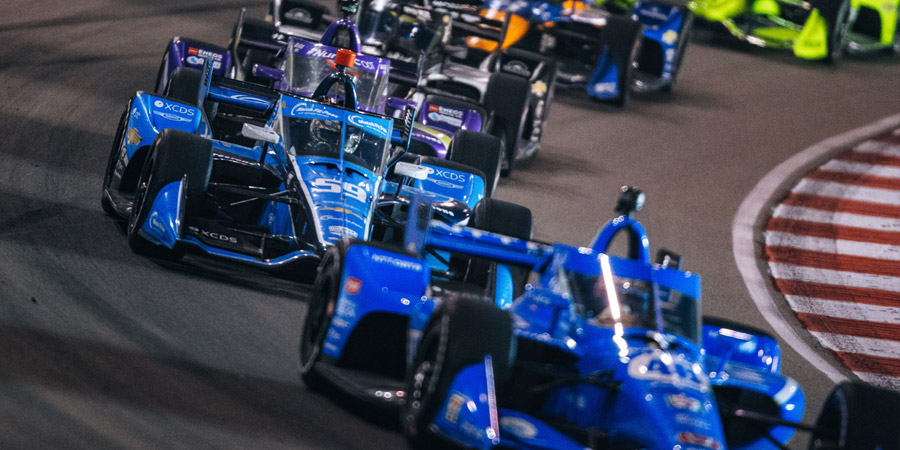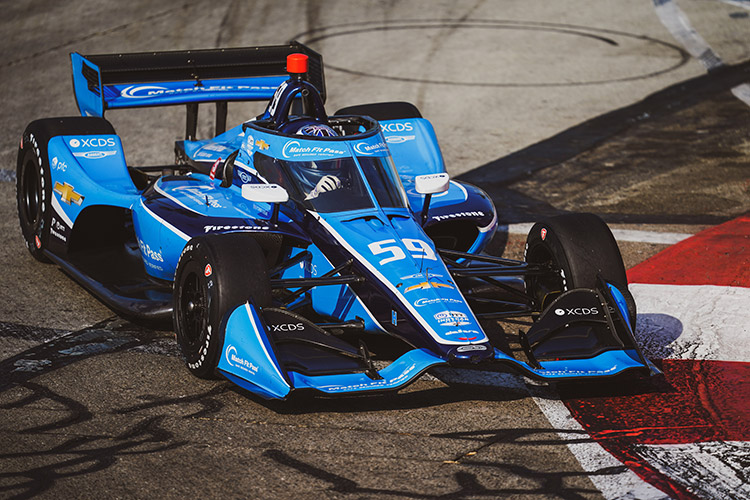Leveraging the Powerful CAD Solution to Push the Boundaries of Design Innovation to Stay Ahead of the Pack
Carlin brings a wealth of knowledge and a winning record to every race
The history of motorsport racing dates back more than 100 years, but in recent decades, the use of advanced technology in car design has taken tuning and performance to the next level. Just look to industry leader Carlin for proof. Carlin is a UK-based motor racing team with more than 20 years of experience competing in eight different championships across single-seater and Le Mans Series racing categories.
Carlin is trusted to give drivers the best possible chance of success on the track. Their experience, combined with their ability to design and develop components for race-winning cars, mean they’ve helped build the careers of some the most renowned drivers in F1, IndyCar, Formula E, and Endurance Racing. They’re also one of the most successful racing teams in the world, taking over 400 victories in their history.
Carlin prioritizes its customer base of exceptionally talented drivers
The motorsport industry is all about speed, and to outperform the competition in racing, teams must equip their drivers with the highest quality, fastest, and most nimble tools—their cars.
Commercial Director Stephanie Carlin explains that Carlin participates in spec series racing, which means that all racing teams start out with the same basic car components, technology, and resources. Teams can then alter the design of certain components in ways that fall within the criteria set forth by industry regulations, which change frequently. “We think about design as a way to improve car performance, increase driver confidence, and ultimately experience faster lap times,” says Carlin. “Our drivers are an exceptionally talented pool of professionals,” she continues. “Where the regulations allow, we will always go above and beyond to push the boundaries of great design to help our drivers get the edge.”
In many ways—and thanks to Carlin’s appetite for continuous design improvement and driver satisfaction—the bar for design ingenuity and technological advancement keeps getting raised. Consequently, the number of opportunities to develop a faster, more efficient race car is often greater than the actual work time available to designers and engineers. “You begin to realize that ‘standard’ isn’t good enough when it comes to design,” says David Brown, Technical Director at Carlin. “We’ve got to be able to do more with the time we have available.” But accomplishing this means that the Carlin team must be intentional about choosing solutions that make the most efficient use of design time—and that ultimately yield more efficient products. This is why they turned to PTC and Creo more than a decade ago—to get a powerful CAD design solution to help optimize their time and improve performance across the board.
Carlin leverages PTC’s Creo to iterate faster and push the boundaries of agile design
Recognizing the importance of making the most efficient use of their time, Carlin is leveraging Creo for continuous design improvement. Creo is the 3D CAD solution that helps designers accelerate product innovation so they can build better products faster.
Creo is an easy-to-learn 3D CAD solution accelerating innovation from product design to manufacturing and beyond. Creo offers a full-spectrum solution that helps maximize efficiencies, including accelerated design timelines; reduced product development costs; improved product quality; and increased customer satisfaction.
Carlin has used Creo to improve overall car and driver performance by focusing on three key use cases:
David Brown
Technical Director, Carlin
Part and assembly performance: Redesigning the IndyCar IR-12 rear anti-roll bar
This suspension part relies of a certain degree of stiffness to help reduce body roll—or sideways tilt—of a vehicle during fast cornering or over road irregularities that may impact tire grip. Prior to redesigning this part in Creo, the bar’s design was such that even at the softest stiffness, it wasn’t producing the desired handling characteristics under certain driving conditions, and any further adjustment would have meant completely disconnecting the bar, rendering it ineffective. Now, using Creo’s 3D design capabilities, Carlin has been able to quickly and accurately define the precise geometries needed to produce a bar that bends and flexes with just the right amount of stiffness to achieve optimal tire traction and better handling.
Coming up with the optimal bar design has required a lot of design iteration, and Carlin relies on Creo Simulation Live to speed iterations and ensure the design will function as intended before going to production. Creo Simulation Live allows designers and engineers to speed the process of design with real-time feedback on how models might respond to physical loads and forces once they’re manufactured and functioning in real environments—all without leaving the CAD environment.
For Carlin, this means having the ability to perform stress analysis to ensure the bar will withstand the real-world forces that occur during high-speed races. But Creo Simulation Live offers some other critical benefits, as well. It reduces iteration time by eliminating the “tweak and wait” process often associated with traditional simulation testing. Every time they make a change to the model, they see instantaneous results within the design environment, rather than having to repeat an entire simulation test from start to finish, as is often the case with other design software.
Lastly, Creo Simulation Live helps create a higher quality product more suited to the track conditions it’s designed for, since they can test the design’s efficacy before going to production. This goes a long way in helping Carlin maximize efficiency within the time they have available.

Holistic systems improvement
Another way Carlin is leveraging Creo is by holistically examining systems in which select parts can be redesigned to improve track performance. One of these areas is weight reduction. The Carlin team determines individual parts that can be redesigned—not for technical improvement to the part itself, but rather because weight reduction across several parts adds up to significant weight reduction for the entire car.
Creo helps them quickly redesign parts, and using Creo Simulation Live, they run stress analyses to ensure they haven’t removed too much material. “We need to make sure we’re accomplishing both goals—removing weight while still ensuring the part functions as needed,” says Brown. “With Creo, we can do that, and we’re seeing substantial savings.”
Another area is fuel system redesign. They’ve used Creo to redesign parts of the system that picks up the fuel from the tank. The design improvements have resulted in a fuel system that is lighter weight, maintains less fuel, and fills more efficiently during a pit stop.
Improved driver confidence
All of the design improvements Carlin makes with Creo serve to make the car more technically efficient—but there’s another even more important benefit. The improved designs put a more responsive and tunable car in the hands of the driver, building the kind of confidence they need to react quickly and win races.
“Driver confidence has the greatest impact on a race,” explains Carlin. “We can change elements of the car, but in the end, it's all about how the driver reacts. Everything we do has to come back to improving lap time, and by working with PTC, we’ve been able to evolve our designs in ways that help drivers accomplish exactly that,” she continues. “Creo allows us to go above and beyond the technology that we start with, and that translates to a stronger performance on the track.”
Stephanie Carlin
Commercial Director, Carlin
The future of racing is bright for Carlin with continuous improvement on the horizon
For the Carlin team, using Creo has already produced significant improvements to handling. From lighter weight cars to more efficient fuel systems, they’re seeing technical improvements that translate to increased confidence among drivers, which naturally leads to better lap times.
The anti-roll bar redesign has also been deployed in up to half of their races this year, and they’re currently tracking and connecting performance metrics such as speed through a particular corner or how quickly a driver applies the throttle.

Carlin believes these outcomes are directly tied to driver satisfaction. In essence, they’re making drivers more effective by improving the efficiency of the tool. “When we run lap simulations on the software, those figures don’t account for driver confidence, only the hard data,” says Brown. “We recognize there’s no scientific measurement for driver confidence. But if you give the driver more confidence, they’ll extract even more efficiencies from their lap time, and that’s something you can’t simulate,” he explains. “When you factor in what that confidence can do, you see some pretty incredible results.”
The Carlin team is looking forward to leveraging Creo for future design needs, as continuous improvement is a key part of how they remain at the forefront of a fast-paced industry. As they continue to empower drivers with more efficient tools, these boundary-breakers are sure to cross the finish line as industry leaders with even more staying power to come.